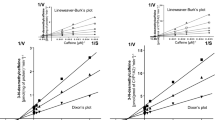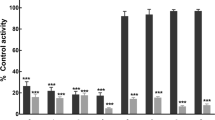Abstract
Purpose
To determine the inhibitory potency of letrozole and its main human metabolite, 4,4′-methanol-bisbenzonitrile, on the activities of eight cytochrome P450 (CYP) enzymes.
Methods
Letrozole and its metabolite were incubated with human liver microsomes (HLMs) (or expressed CYP isoforms) and NADPH in the absence (control) and presence of the test inhibitor.
Results
Letrozole was a potent competitive inhibitor of CYP2A6 (K i 4.6 ± 0.05 μM and 5.0 ± 2.4 μM in HLMs and CYP2A6, respectively) and a weak inhibitor of CYP2C19 (K i 42.2 μM in HLMs and 33.3 μM in CYP2C19), while its metabolite showed moderate inhibition of CYP2C19 and CYP2B6. Letrozole or its metabolite had negligible effect on other CYPs.
Conclusions
Based on the in vitro K i values, letrozole is predicted to be a weak inhibitor of CYP2A6 in vivo. Letrozole and its major human metabolite show inhibitory activity towards other CYPs, but clinically relevant drug interactions seem less likely as the K i values are above the therapeutic plasma concentrations of letrozole.





Similar content being viewed by others
Abbreviations
- CYPs:
-
Cytochrome P450s
- HLMs:
-
Human liver microsomes
- HPLC:
-
High-performance liquid chromatography
References
Yager JD, Davidson NE (2006) Estrogen carcinogenesis in breast cancer. N Engl J Med 354:270–282
Osborne CK (1998) Tamoxifen in the treatment of breast cancer. N Engl J Med 339:1609–1618
Buzdar AU, Robertson JF (2006) Fulvestrant: pharmacologic profile versus existing endocrine agents for the treatment of breast cancer. Ann Pharmacother 40:1572–1583
Smith IE, Dowsett M (2003) Aromatase inhibitors in breast cancer. N Engl J Med 348:2431–2442
Ryan KJ (1959) Biological aromatization of steroids. J Biol Chem 234:268–272
Scott LJ, Keam SJ (2006) Letrozole: in postmenopausal hormone-responsive early-stage breast cancer. Drugs 66:353–362
Thurlimann B, Keshaviah A, Coates AS et al (2005) A comparison of letrozole and tamoxifen in postmenopausal women with early breast cancer. N Engl J Med 353:2747–2757
Coombes RC, Hall E, Gibson LJ et al (2004) A randomized trial of exemestane after two to three years of tamoxifen therapy in postmenopausal women with primary breast cancer. N Engl J Med 350:1081–1092
Buzdar AU, Coombes RC, Goss PE, Winer EP (2008) Summary of aromatase inhibitor clinical trials in postmenopausal women with early breast cancer. Cancer 112:700–709
Jin Y, Desta Z, Stearns V et al (2005) CYP2D6 genotype, antidepressant use, and tamoxifen metabolism during adjuvant breast cancer treatment. J Natl Cancer Inst 97:30–39
Borges S, Desta Z, Li L et al (2006) Quantitative effect of CYP2D6 genotype and inhibitors on tamoxifen metabolism: implication for optimization of breast cancer treatment. Clin Pharmacol Ther 80:61–74
Bhatnagar AS (2007) The discovery and mechanism of action of letrozole. Breast Cancer Res Treat 105(Suppl 1):7–17
Wrz B, Valles B, Parkinson A, Madan A, Probst A, Zimmerlin A, Gut J (1996) CYP3A4 and CYP2A6 are involved in the biotransformation of letrozole. ISSX Proc 10:359 (Abstract)
Grimm SW, Dyroff MC (1997) Inhibition of human drug metabolizing cytochromes P450 by anastrozole, a potent and selective inhibitor of aromatase. Drug Metab Dispos 25:598–602
Venkatakrishnan K, Von Moltke LL, Greenblatt DJ (2000) Effects of the antifungal agents on oxidative drug metabolism: clinical relevance. Clin Pharmacokinet 38:111–180
Desta Z, Ward BA, Flockhart DA (2005) In vitro letrozole N-dealkylation is mainly catalyzed by human cytochrome P450 (CYP) 3A. Clin Pharmacol Ther 77:79 (Abstract)
Product information. Novartis Pharmaceutical Canada Inc. Prescribing information femara1 (letrozole). http://www.pharma.ca.novartis.com/downloads/e/femara_scrip_e.pdf (online 23 April 2007)
Pfister CU, Martoni A, Zamagni C et al (2001) Effect of age and single versus multiple dose pharmacokinetics of letrozole (Femara) in breast cancer patients. Biopharm Drug Dispos 22:191–197
Tao X, Piao H, Canney DJ, Borenstein MR, Nnane IP (2007) Biotransformation of letrozole in rat liver microsomes: effects of gender and tamoxifen. J Pharm Biomed Anal 43:1078–1085
Bradford MM (1976) A rapid and sensitive method for the quantitation of microgram quantities of protein utilizing the principle of protein-dye binding. Anal Biochem 72:248–254
Jeong S, Nguyen PD, Desta Z (2009) Comprehensive in vitro inhibition analysis of 8 cytochrome P450 (CYP) enzymes by voriconazole: major effect on CYPs 2B6, 2C9, 2C19 and 3A. Antimicrob Agents Chemother 53:541–551
Ko JW, Sukhova N, Thacker D, Chen P, Flockhart DA (1997) Evaluation of omeprazole and lansoprazole as inhibitors of cytochrome P450 isoforms. Drug Metab Dispos 25:853–862
Greenlee WF, Poland A (1978) An improved assay of 7-ethoxycoumarin O-deethylase activity: induction of hepatic enzyme activity in C57BL/6J and DBA/2J mice by phenobarbital, 3-methylcholanthrene and 2, 3, 7, 8-tetrachlorodibenzo-p-dioxin. J Pharmacol Exp Ther 205:596–605
Pearce R, Greenway D, Parkinson A (1992) Species differences and interindividual variation in liver microsomal cytochrome P450 2A enzymes: effects on coumarin, dicumarol, and testosterone oxidation. Arch Biochem Biophys 298:211–225
Draper AJ, Madan A, Parkinson A (1997) Inhibition of coumarin 7-hydroxylase activity in human liver microsomes. Arch Biochem Biophys 341:47–61
Ward BA, Gorski JC, Jones DR, Hall SD, Flockhart DA, Desta Z (2003) The cytochrome P4502B6 (CYP2B6) is the main catalyst of efavirenz primary and secondary metabolism: Implication for HIV/AIDS therapy and utility of efavirenz as a substrate marker of CYP2B6 catalytic activity. J Pharmacol Exp Ther 306:287–300
Li XQ, Bjorkman A, Andersson TB, Ridderstrom M, Masimirembwa CM (2002) Amodiaquine clearance and its metabolism to N-desethylamodiaquine is mediated by CYP2C8: a new high affinity and turnover enzyme-specific probe substrate. J Pharmacol Exp Ther 300:399–407
Parikh S, Ouedraogo JB, Goldstein JA, Rosenthal PJ, Kroetz DL (2007) Amodiaquine metabolism is impaired by common polymorphisms in CYP2C8: implications for malaria treatment in Africa. Clin Pharmacol Ther 82:197–203
Wang YH, Jones DR, Hall SD (2005) Differential mechanism-based inhibition of CYP3A4 and CYP3A5 by verapamil. Drug Metab Dispos 33:664–671
Desta Z, Kerbusch T, Soukhova N, Richard E, Ko JW, Flockhart DA (1998) Identification and characterization of human cytochrome P450 isoforms interacting with pimozide. J Pharmacol Exp Ther 285:428–437
Desta Z, Soukhova N, Mahal SK, Flockhart DA (2000) Interaction of cisapride with the human cytochrome P450 system: metabolism and inhibition studies. Drug Metab Dispos 28:789–800
Bourrie M, Meunier V, Berger Y, Fabre G (1996) Cytochrome P450 isoform inhibitors as a tool for the investigation of metabolic reactions catalyzed by human liver microsomes. J Pharmacol Exp Ther 277:321–332
Colussi DM, Parisot CY, Lefevre GY (1998) Plasma protein binding of letrozole, a new nonsteroidal aromatase enzyme inhibitor. J Clin Pharmacol 38:727–735
Xu C, Goodz S, Sellers EM, Tyndale RF (2002) CYP2A6 genetic variation and potential consequences. Adv Drug Deliv Rev 54:1245–1256
Sioufi A, Gauducheau N, Pineau V et al (1997) Absolute bioavailability of letrozole in healthy postmenopausal women. Biopharm Drug Dispos 18:779–789
Liu XD, Xie L, Zhong Y, Li CX (2000) Gender difference in letrozole pharmacokinetics in rats. Acta Pharmacol Sin 21:680–684
Ingle JN, Suman VJ, Johnson PA et al (1999) Evaluation of tamoxifen plus letrozole with assessment of pharmacokinetic interaction in postmenopausal women with metastatic breast cancer. Clin Cancer Res 5:1642–1649
Acknowledgments
This study was supported in part by a Pharmacogenetics Research Network Grant (U-01 GM61373), which supports the Consortium on Breast Cancer Pharmacogenomics (COBRA), a Clinical Pharmacology training Grant (T32GM008425) and an RO1 grant (1R01GM078501-01A1) from the National Institute of General Medical Sciences, National Institutes of Health (Bethesda, MD), and by a fellowship award to Dr. Jeong from the Research Institute of Medical Science of Chonnam National University, Gwangju, S. Korea.
Conflict of interest statement
The authors have no conflict of interest.
Author information
Authors and Affiliations
Corresponding author
Rights and permissions
About this article
Cite this article
Jeong, S., Woo, M.M., Flockhart, D.A. et al. Inhibition of drug metabolizing cytochrome P450s by the aromatase inhibitor drug letrozole and its major oxidative metabolite 4,4′-methanol-bisbenzonitrile in vitro. Cancer Chemother Pharmacol 64, 867–875 (2009). https://doi.org/10.1007/s00280-009-0935-7
Received:
Accepted:
Published:
Issue Date:
DOI: https://doi.org/10.1007/s00280-009-0935-7




